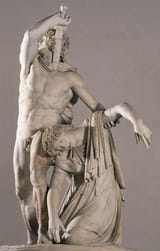The sculpture Gaul Killing Himself and His Wife stands as an immortal testament to the Hellenic understanding of fate, honour, and transcendence. In this act of defiance, the Gaul transforms the agony of defeat into eternal glory—his blade becomes a sacred instrument of liberation, severing the chains of mortal humiliation and elevating his soul to the eternal order of the cosmos. Through Hellenism, even the depths of despair are alchemised into a timeless reflection of dignity, virtue, and divine ascent. His wife, slain by his hand, symbolises an unbroken unity—a tragic yet sacred act embodying the cosmic balance of existence. Together, they reflect the highest Hellenic ideals of areté and kleos, transforming mortal tragedy into transcendence, where the human spirit aligns with the eternal will of the gods and the immutable order of the cosmos.
